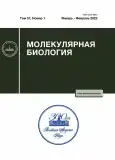Anti-Restriction Activity of ArdB Protein against EcoAI Endonuclease
- Authors: Kudryavtseva A.A.1, Alekhin V.A.2, Lebedeva M.D.2, Csefalvay E.3, Weiserova .4, Manukhov I.V.1,5
-
Affiliations:
- Moscow Institute of Physics and Technology
- “Biophystech” LLC
- Laboratory of Structural Biology and Bioinformatics, Institute of Microbiology, Academy of Sciences of the Czech Republic
- Institute of Microbiology, Academy of Sciences of the Czech Republic
- Moscow State University of Food Production
- Issue: Vol 57, No 1 (2023)
- Pages: 101-105
- Section: МОЛЕКУЛЯРНАЯ БИОЛОГИЯ КЛЕТКИ
- URL: https://journals.rcsi.science/0026-8984/article/view/138616
- DOI: https://doi.org/10.31857/S0026898423010056
- EDN: https://elibrary.ru/AWVMVU
- ID: 138616
Cite item
Full Text
Abstract
ArdB proteins are known to inhibit the activity of type I restriction–modification (RM-I) system, in particular EcoKI (family IA). The mechanism of ArdB’s activity still remains unknown; the spectrum of targets inhibited by them has been poorly studied. In this work, it was shown that the presence of the ardB gene from R64 plasmid could suppress the activity of EcoAI endonuclease (IB family) in Escherichia coli TG1 cells. The absence of specificity of ArdB to a certain RM-I system (it inhibits both the IA- and IB-family), it can be a-ssumed that the mechanism of the anti-restriction activity of this protein does not depend on both the s-equence DNA at the recognition site and the structure of the restrictase of the RM-I systems.
Keywords
About the authors
A. A. Kudryavtseva
Moscow Institute of Physics and Technology
Author for correspondence.
Email: kudryavtseva@phystech.edu
Russia, 141707, Moscow Region, Dolgoprudny
V. A. Alekhin
“Biophystech” LLC
Email: kudryavtseva@phystech.edu
Russia, 141701, Moscow Region, Dolgoprudny
M. D. Lebedeva
“Biophystech” LLC
Email: kudryavtseva@phystech.edu
Russia, 141701, Moscow Region, Dolgoprudny
E. Csefalvay
Laboratory of Structural Biology and Bioinformatics, Institute of Microbiology, Academy of Sciences of the Czech Republic
Email: kudryavtseva@phystech.edu
Czech Republic, 37333 , Nove Hrady, Zamek 136
M. Weiserova
Institute of Microbiology, Academy of Sciences of the Czech Republic
Email: kudryavtseva@phystech.edu
Czech Republic, 14220, Praha 4,, Vídeňská 1083
I. V. Manukhov
Moscow Institute of Physics and Technology; Moscow State University of Food Production
Email: kudryavtseva@phystech.edu
Russia, 141707, Moscow Region, Dolgoprudny; Russia, 125080, Moscow
References
- Samson J.E., Magadán A.H., Moineau S., Sabri M. (2013) Revenge of the phages: defeating bacterial defences. Nat. Rev. Microbiol. 11, 675‒687.
- Tock M.R., Dryden D.T. (2005) The biology of restriction and anti-restriction. Curr. Opin. Microbiol. 8, 466–472.
- Liang W., Xie Y., Lu Y, Xiong W., Tang Y., Li G., Jiang X., Lu Y. (2017) Anti-restriction protein, KlcAHS, promotes dissemination of carbapenem resistance. Front. Cell. Infect. Microbiol. 7, 150.
- McMahon S.A., Roberts G.A., Johnson K.A., Cooper L.P., Liu H., White J.H., Carter L.G., Sanghvi B., Oke M., Walkinshaw M.D., Blakely G.W., Naismith J.H., Dryden D.T. (2009) Extensive DNA mimicry by the ArdA anti-restriction protein and its role in the spread of antibiotic resistance. Nucleic Acids Res. 37, 4887–4897.
- Roberts G.A., Stephanou A.S., Kanwar N., Dawson A., Cooper L.P., Chen K., Nutley M., Cooper A., Blakely G.W., Dryden D.T. (2012) Exploring the DNA mimicry of the Ocr protein of phage T7. Nucleic Acids Res. 40, 8129–8143.
- Goryanin I.I., Kudryavtseva A.A., Balabanov V.P., Biryukova V.S., Manukhov I.V., Zavilgelsky G.B. (2018) Antirestriction activities of KlcA (RP4) and ArdB (R64) proteins. FEMS Microbiol. Lett. 365, fny227.
- Кудрявцева А.А., Охрименко И.С., Дидина В.С., Завильгельский Г.Б., Манухов И.В. (2020) Антирестрикционный белок ArdB (R64) взаимодействует с ДНК. Биохимия. 85, 369–377.
- Balabanov V.P., Kudryavtseva A.A., Melkina O.E., Pustovoit K.S., Khrulnova S.A., Zavilgelsky G.B. (2019) ArdB protective activity for unmodified λ phage against EcoKI restriction decreases in UV-treated Escherichia coli. Curr. Microbiol. 76, 1374–1378.
- Belogurov A.A., Delver E.P., Rodzevich O.V. (1993) Plasmid pKM101 encodes two nonhomologous antirestriction proteins (ArdA and ArdB) whose expression is controlled by homologous regulatory sequences. J. Bacteriol. 175, 4843–4850.
- Serfiotis-Mitsa D., Herbert A.P., Roberts G.A., Soares D.C., White J.H., Blakely G.W., Uhrín D., Dryden D.T. (2010) The structure of the KlcA and ArdB proteins reveals a novel fold and antirestriction activity against type I DNA restriction systems in vivo but not in vitro. Nucleic Acids Res. 38, 1723–1737.
- Маниатис Т., Фрич Э., Сэмбрук Дж. (1984) Молекулярное клонирование. Москва: Мир.
- Кудрявцева А.А., Осетрова М.С., Ливинюк В.Я., Манухов И.В., Завильгельский Г.Б. (2017) С-концевой остаток аспарагиновой кислоты (D141) необходим для антирестрикционной активности белка ArdB (R64). Молекуляр. биология. 51(5), 831–835.
- Завильгельский Г.Б., Мершавка В.Ю., Юсифов Т.Н., Белогуров А.А. (1984) Ослабление рестрикции ЕсоК ДНК бактериофага в присутствии плазмиды pKM101 ard+. I. Общая характеристика и генетическая локализация. Молекуляр. биология. 18(6), 1590–1596.
- Манухов И.В., Коноплева М.Н., Баженов С.В. (2016) Практикум по генетической инженерии. Черноголовка: Редакционно-издательский отдел ИПХФ РАН.
- Kan N.C., Lautenberger J.A., Edgell M.H., Hutchison C.A. (1979) The nucleotide sequence recognized by the Escherichia coli K12 restriction and modification enzymes. J. Mol. Biol. 130(2), 191–209. https://doi.org/10.1016/0022-2836(79)90426-1
- Kröger M., Hobom G. (1984) The nucleotide sequence recognized by the Escherichia coli A restriction and modification enzyme. Nucleic Acids Res. 12(2), 887–899. https://doi.org/10.1093/nar/12.2.887
Supplementary files










